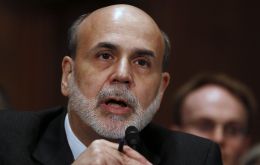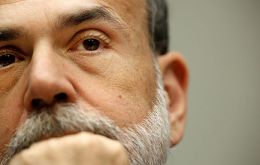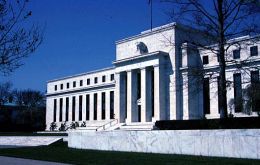MercoPress. South Atlantic News Agency
Tag: Federal Reserve
-
Wednesday, August 24th 2011 - 06:47 UTC
World markets higher on expectations of Bernanke speech Thursday

US stocks shot 3% higher on Tuesday on speculation Federal Reserve Chairman Ben Bernanke this week could signal new help for the US economy, giving investors hope a four-week rout was nearing an end.
-
Wednesday, August 10th 2011 - 07:35 UTC
US, EU and Asian markets rebound strongly on Fed Reserve announcement

Asian markets rebounded after the US Federal Reserve said it will keep interest rates on hold and Wall Street had its best day in two years. The decision by the US central bank to keep rates at current levels until at least 2013 helped stem one of the biggest sell-offs in recent years.
-
Tuesday, August 9th 2011 - 20:11 UTC
Federal Reserve anticipates low rates and current stimuli level through mid-2013

The Federal Reserve said on Tuesday it will keep its hefty monetary policy stimulus for at least another two years, an effort to support a flagging economy and fragile global markets that face considerable selling spree.
-
Thursday, July 28th 2011 - 11:27 UTC
US economic recovery slowed down in June says Fed’s Beige Book

The pace of United States economic growth slowed last month in eight of the 12 Federal Reserve Districts, the central bank said Wednesday in the latest edition of its Beige Book report.
-
Thursday, July 14th 2011 - 18:27 UTC
Bernanke warns Congress of “calamitous outcome” if the US defaults on its debt

Federal Reserve Chairman Ben Bernanke warned the United States Congress that overzealous cuts to government spending could derail an already fragile recovery and said a US debt default could wreak financial havoc.
-
Wednesday, July 13th 2011 - 16:30 UTC
Fed ready to inject new stimulus if US economy remains persistently weak

Federal Reserve Chairman Ben Bernanke said the central bank is ready to ease monetary policy further if the economy weakens and inflation moves lower, suggesting policymakers are actively mulling further stimulus.
-
Thursday, June 30th 2011 - 06:58 UTC
IMF urges a political agreement on the US federal debt ceiling

Failure by US lawmakers to agree soon on a deal to raise the government's borrowing limit could deliver a “severe shock” to a still fragile recovery and global markets, the International Monetary Fund warned.
-
Monday, June 27th 2011 - 18:48 UTC
Federal Reserve will remain biggest buyer of US Treasury bills

The Federal Reserve will remain the biggest buyer of Treasuries, even after the second round of quantitative easing ends this week, as the central bank uses its 2.86 trillion US dollars balance sheet to keep interest rates low.
-
Friday, June 24th 2011 - 22:44 UTC
US economy expanded at a 1.9% annual pace in the first quarter

The United States economy grew at a 1.9% pace in the first quarter marking the start of what Federal Reserve policy makers anticipate is a temporary slowdown in growth.
-
Wednesday, June 22nd 2011 - 23:36 UTC
Fed admits it does not have a “precise read” of why US economy is slowing

The Federal Reserve has cut its growth forecast for the US economy in the face of the impact of higher energy prices. It now estimates that the US economy will expand between 2.7% and 2.9% this year, down from its April forecast of 3.1% to 3.3%.
